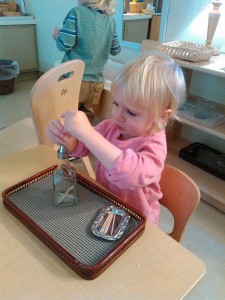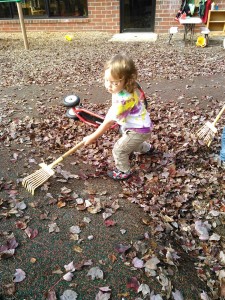Few things are quite as alarming to parents as being smacked by their once-serene toddler, or watching her use aggression against another child. For so many of us, peaceful conflict resolution and gentle interactions are among the most important values we strive to instill in our children. It can be easy to wonder how toddlers in perfectly peaceful households can suddenly turn all Vin Diesel on those they love the most!
Almost all young children experiment with aggressive behaviors, even in the very best homes and toddler programs. All toddlers - even those who are never exposed to physical aggression or violent imagery - are wired to resolve conflicts in ways that are reactive and impulsive. Because they haven't yet mastered verbal communication, their hands are often the medium through which they express how they feel. On top of that, they are not yet capable of empathizing with others to understand how their actions feel to those on the receiving end. Behaviors like hitting and pushing offer a quick release to their feelings of frustration, get others out of their space - and, for bonus points, they get BIG reactions from grown-ups. Toddlers crave attention, and even the negative variety can feel gratifying. Moreover, getting an adult or another child riled up offers a little taste of POWER - a feeling that’s in short supply in a small child’s life. Therefore, toddlers will often repeat unwanted behaviors over and over just to experience that rush of emotion, and to see how the sequence of reactions plays out each time.
Your toddler knows you love him unconditionally, regardless of his actions - so you're a safe target for behaviors he wants to understand and explore, even if they are negative. In most cases, the best response is as LITTLE response as possible: "No hitting. That hurts me," then moving physically away from the child. You can say, "I can be with you when you're gentle." At school, we may ask children who are behaving aggressively to move away from the rest of the group; do some deep breathing (smell the flower [inhale], blow out the candle [exhale]); then ask them to touch our hand gently to show us they are ready to be close to others again. When they are calm, we help them to recognize the impact of their actions: “Your friend is crying. It hurt when you hit her.” Then we model the language the child might use in the future in lieu of the aggressive behavior: “You can say, ‘Move over, please.’" Toddlers learn via LOTS of repetition, so don't be surprised or discouraged if you find you are using these interventions over and over with seemingly little result. They are programmed to test certain behaviors again and again before they accept that the result is the same every time!
Of all the things we cover in the toddler curriculum, none is more important than teaching children how to exist in a community with others and resolve conflicts peacefully. Monitoring the children for their safety and well-being, and seizing every opportunity to teach prosocial behavior, is incredibly important to everyone on our Toddler faculty. With patience, good modeling, and consistency in our approaches at home and school, we can help toddlers to master alternatives to the "rough stuff" and become caring, empathetic members of our school family!
 A toddler is seated at a small table, carefully guiding a toothpick through the tiny hole in the top of an oil & vinegar shaker. Beside him, a classmate carefully pours water into a vase before adding a few small stems of flowers. Nearby, a teacher and children use blunt slicers to prepare cucumbers for the morning snack. Scenes like these are hallmarks of the Montessori toddler classroom, and look quite different from many other early childhood settings. To the unaccustomed eye, the purpose of these activities, cobbled together from seemingly random household items, can be difficult to discern. But upon close inspection, one notices that the first child holds the toothpick with a grasp closely resembling the pencil grip he'll eventually master. His classmate is developing focus and concentration as the flowers engage her senses of sight, smell, touch, and aesthetic awareness. And those involved in the preparation of the healthy snack are now inclined to sample it themselves.
A toddler is seated at a small table, carefully guiding a toothpick through the tiny hole in the top of an oil & vinegar shaker. Beside him, a classmate carefully pours water into a vase before adding a few small stems of flowers. Nearby, a teacher and children use blunt slicers to prepare cucumbers for the morning snack. Scenes like these are hallmarks of the Montessori toddler classroom, and look quite different from many other early childhood settings. To the unaccustomed eye, the purpose of these activities, cobbled together from seemingly random household items, can be difficult to discern. But upon close inspection, one notices that the first child holds the toothpick with a grasp closely resembling the pencil grip he'll eventually master. His classmate is developing focus and concentration as the flowers engage her senses of sight, smell, touch, and aesthetic awareness. And those involved in the preparation of the healthy snack are now inclined to sample it themselves.- Promote a sense of pride and ownership in the classroom environment.
- Enable children to interact with real-world objects, mastering the use of tongs, juicers, tweezers, rakes, basters, and other implements they'll encounter for the rest of their lives.
- Enhance physical coordination, promoting both large and small muscle development.
- Build independence and self-esteem by providing toddlers opportunities to care for themselves.
- Convey a sense of trust between caregivers and children, communicating that we see them as capable and worthy of using the real tools, kitchen devices, and other household items they long to explore but are often forbidden.
- Allow children the gratification of completing a defined task from start to finish.



